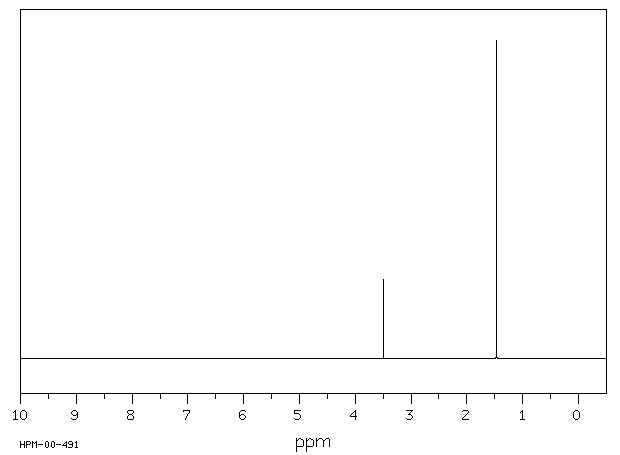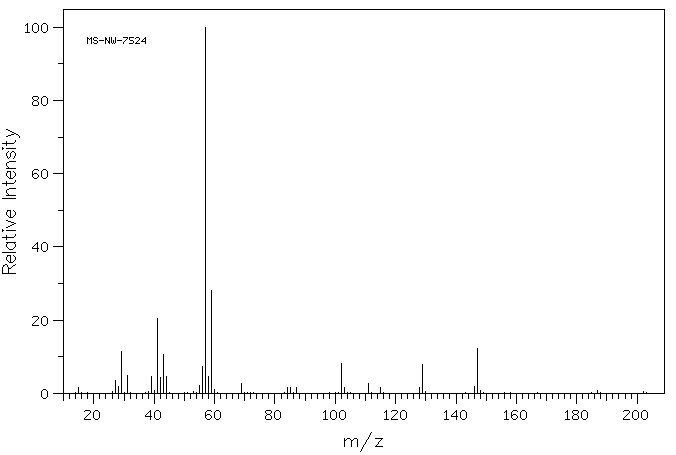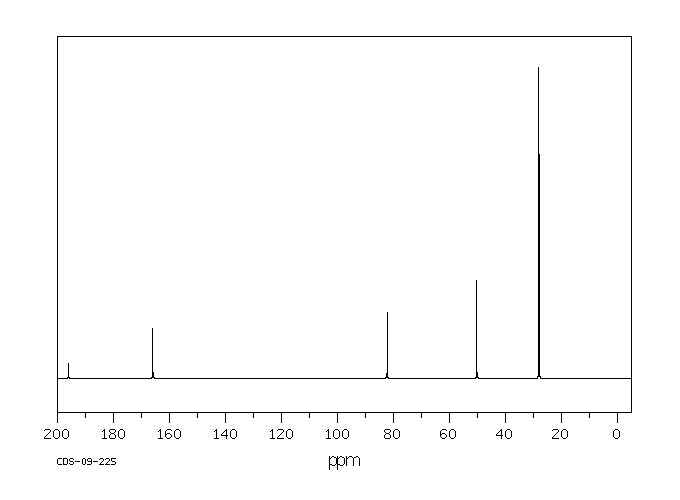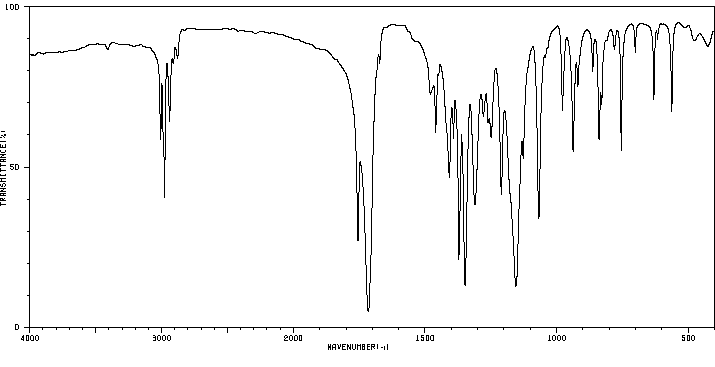3-氧化戊二酸二叔丁酯 | 28009-80-5
中文名称
3-氧化戊二酸二叔丁酯
中文别名
二叔丁基1,3-丙酮二羧酸酯;1,3-丙酮二羧酸二叔丁酯
英文名称
di-tert-butyl 1,3-acetonedicarboxylate
英文别名
Bis(1,1-dimethylethyl) 3-oxoglutarate;ditert-butyl 3-oxopentanedioate
CAS
28009-80-5
化学式
C13H22O5
mdl
——
分子量
258.315
InChiKey
KREDQIDLGFBDMQ-UHFFFAOYSA-N
BEILSTEIN
——
EINECS
——
-
物化性质
-
计算性质
-
ADMET
-
安全信息
-
SDS
-
制备方法与用途
-
上下游信息
-
文献信息
-
表征谱图
-
同类化合物
-
相关功能分类
-
相关结构分类
物化性质
-
熔点:58-60 °C (lit.)
-
溶解度:可溶于甲醇:1g/10mL,澄清,无色至淡黄色
-
稳定性/保质期:
遵照规定使用和储存,则不会发生分解。
计算性质
-
辛醇/水分配系数(LogP):2
-
重原子数:18
-
可旋转键数:8
-
环数:0.0
-
sp3杂化的碳原子比例:0.77
-
拓扑面积:69.7
-
氢给体数:0
-
氢受体数:5
安全信息
-
WGK Germany:3
-
储存条件:存放于2-8℃阴凉干燥处
SDS
Section 1. IDENTIFICATION OF THE SUBSTANCE/MIXTURE
Product identifiers
Product name : Di-tert-butyl 1,3-acetonedicarboxylate
CAS-No. : 28009-80-5
Relevant identified uses of the substance or mixture and uses advised against
Identified uses : Laboratory chemicals, Manufacture of substances
Section 2. HAZARDS IDENTIFICATION
Classification of the substance or mixture
Not a hazardous substance or mixture according to Regulation (EC) No. 1272/2008.
Not a hazardous substance or mixture according to EC-directives 67/548/EEC or 1999/45/EC.
Label elements
The product does not need to be labelled in accordance with EC directives or respective national laws.
Other hazards - none
Section 3. COMPOSITION/INFORMATION ON INGREDIENTS
Substances
Synonyms : Di-tert-butyl 3-oxoglutarate
Formula : C13H22O5
Molecular Weight : 258,31 g/mol
Section 4. FIRST AID MEASURES
Description of first aid measures
If inhaled
If breathed in, move person into fresh air. If not breathing, give artificial respiration.
In case of skin contact
Wash off with soap and plenty of water.
In case of eye contact
Flush eyes with water as a precaution.
If swallowed
Never give anything by mouth to an unconscious person. Rinse mouth with water.
Most important symptoms and effects, both acute and delayed
Indication of any immediate medical attention and special treatment needed
no data available
Section 5. FIREFIGHTING MEASURES
Extinguishing media
Suitable extinguishing media
Use water spray, alcohol-resistant foam, dry chemical or carbon dioxide.
Special hazards arising from the substance or mixture
Carbon oxides
Advice for firefighters
Wear self contained breathing apparatus for fire fighting if necessary.
Further information
no data available
Section 6. ACCIDENTAL RELEASE MEASURES
Personal precautions, protective equipment and emergency procedures
Avoid dust formation. Avoid breathing vapors, mist or gas.
Environmental precautions
Do not let product enter drains.
Methods and materials for containment and cleaning up
Sweep up and shovel. Keep in suitable, closed containers for disposal.
Reference to other sections
For disposal see section 13.
Section 7. HANDLING AND STORAGE
Precautions for safe handling
Provide appropriate exhaust ventilation at places where dust is formed.Normal measures for preventive fire
protection.
Conditions for safe storage, including any incompatibilities
Store in cool place. Keep container tightly closed in a dry and well-ventilated place.
Specific end uses
no data available
Section 8. EXPOSURE CONTROLS/PERSONAL PROTECTION
Control parameters
Components with workplace control parameters
Exposure controls
Appropriate engineering controls
General industrial hygiene practice.
Personal protective equipment
Eye/face protection
Use equipment for eye protection tested and approved under appropriate government standards
such as NIOSH (US) or EN 166(EU).
Skin protection
Handle with gloves. Gloves must be inspected prior to use. Use proper glove removal technique
(without touching glove's outer surface) to avoid skin contact with this product. Dispose of
contaminated gloves after use in accordance with applicable laws and good laboratory practices.
Wash and dry hands.
The selected protective gloves have to satisfy the specifications of EU Directive 89/686/EEC and
the standard EN 374 derived from it.
Body Protection
Choose body protection in relation to its type, to the concentration and amount of dangerous
substances, and to the specific work-place., The type of protective equipment must be selected
according to the concentration and amount of the dangerous substance at the specific workplace.
Respiratory protection
Respiratory protection is not required. Where protection from nuisance levels of dusts are desired,
use type N95 (US) or type P1 (EN 143) dust masks. Use respirators and components tested and
approved under appropriate government standards such as NIOSH (US) or CEN (EU).
Section 9. PHYSICAL AND CHEMICAL PROPERTIES
Information on basic physical and chemical properties
a) Appearance Form: crystalline
Colour: beige
b) Odour no data available
c) Odour Threshold no data available
d) pH no data available
e) Melting point/freezing Melting point/range: 58 - 60 °C - lit.
point
f) Initial boiling point and no data available
boiling range
g) Flash point no data available
h) Evaporation rate no data available
i) Flammability (solid, gas) no data available
j) Upper/lower no data available
flammability or
explosive limits
k) Vapour pressure no data available
l) Vapour density no data available
m) Relative density no data available
n) Water solubility no data available
o) Partition coefficient: n- no data available
octanol/water
p) Autoignition no data available
temperature
q) Decomposition no data available
temperature
r) Viscosity no data available
s) Explosive properties no data available
t) Oxidizing properties no data available
Other safety information
no data available
Section 10. STABILITY AND REACTIVITY
Reactivity
no data available
Chemical stability
no data available
Possibility of hazardous reactions
no data available
Conditions to avoid
no data available
Incompatible materials
Strong oxidizing agents
Hazardous decomposition products
Other decomposition products - no data available
Section 11. TOXICOLOGICAL INFORMATION
Information on toxicological effects
Acute toxicity
no data available
Skin corrosion/irritation
no data available
Serious eye damage/eye irritation
no data available
Respiratory or skin sensitization
no data available
Germ cell mutagenicity
no data available
Carcinogenicity
IARC: No component of this product present at levels greater than or equal to 0.1% is identified as
probable, possible or confirmed human carcinogen by IARC.
Reproductive toxicity
no data available
Specific target organ toxicity - single exposure
no data available
Specific target organ toxicity - repeated exposure
no data available
Aspiration hazard
no data available
Potential health effects
Inhalation
May be harmful if inhaled. May cause respiratory tract irritation.
Ingestion May be harmful if swallowed.
Skin May be harmful if absorbed through skin. May cause skin irritation.
Eyes May cause eye irritation.
Additional Information
RTECS: Not available
Section 12. ECOLOGICAL INFORMATION
Toxicity
no data available
Persistence and degradability
no data available
Bioaccumulative potential
no data available
Mobility in soil
no data available
Results of PBT and vPvB assessment
no data available
Other adverse effects
no data available
Section 13. DISPOSAL CONSIDERATIONS
Waste treatment methods
Product
Offer surplus and non-recyclable solutions to a licensed disposal company.
Contaminated packaging
Dispose of as unused product.
Section 14. TRANSPORT INFORMATION
UN number
ADR/RID: - IMDG: - IATA: -
UN proper shipping name
ADR/RID: Not dangerous goods
IMDG: Not dangerous goods
IATA: Not dangerous goods
Transport hazard class(es)
ADR/RID: - IMDG: - IATA: -
Packaging group
ADR/RID: - IMDG: - IATA: -
Environmental hazards
ADR/RID: no IMDG Marine pollutant: no IATA: no
Special precautions for user
no data available
SECTION 15 - REGULATORY INFORMATION
N/A
SECTION 16 - ADDITIONAL INFORMATION
N/A
反应信息
-
作为反应物:描述:参考文献:名称:氰基(·CH 2 CN)和(叔丁氧基)羰基甲基(·CH 2 CO 2 C(CH 3)3)自由基加成溶液中烯烃的绝对速率常数摘要:通过时间分辨电子自旋共振确定绝对速率常数及其温度依赖性,方法是将自由基·CH 2 CN和·CH 2 CO 2 C(CH 3)3添加到各种单取代和1,1-二取代基中并在乙腈溶液中选择1,2-和三取代的烯烃。·CH 2 CN在烯烃CH 2 CXY处以未取代的C原子加成,其速率常数范围为3.3·10 3 M -1 S -1(乙烯)至2.4·10 6 M -1 S -1(1,1-二苯基乙烯)在278 K,并且频率因子在log的窄范围内(A / M -1 S -1)= 8.7±0.3。·CH 2 CO 2 C(CH 3)3具有非常相似的反应性,在296 K时的速率常数为1.1·10 4 M -1 S -1(乙烯)至10 7 M -1 S -1(1,1 -二苯乙烯)和频率因子log(A / M -1 S -1)= 8.4±0.1。对于两个自由基,速率常数和添加到CH 2中的活化能CXY与总反应焓密切相DOI:10.1002/hlca.19950780118
-
作为产物:描述:丙二酸单叔丁酯 在 O-(N-succinimidyl)-N,N,N',N'-tetramethyluronium tetrafluoroborate 、 N,N-二异丙基乙胺 作用下, 以 N,N-二甲基甲酰胺 为溶剂, 反应 0.5h, 以96%的产率得到3-氧化戊二酸二叔丁酯参考文献:名称:活化丙二酸半酯的自缩合:聚酮化合物生物合成中脱羧性克莱森缩合的模型摘要:丙二酸半含氧酸酯与N-羟基琥珀酰亚胺基酯形成试剂的反应导致自缩合,从而提供相应的1,3-丙酮二羧酸二酯。此新方法不需要二价金属螯合剂或配位溶剂即可成功缩合。DOI:10.1016/j.tetlet.2003.08.014
文献信息
-
General approach for the synthesis of polyquinenes via the weiss reaction XII. The chugaev approach to ellacene (1,10-cyclododecanotriquinancene)作者:Xiaoyong Fu、James M. CookDOI:10.1016/s0040-4039(00)97409-4日期:1990.1The synthesis of ellacene (1,10-cyclododecanotriquinancene) 2 has been achieved via the Weiss reaction. The regiospecific monoallylation of 6 to provide 7, and the pyrolysis of tris xanthate 11 in HMPA at 220°C to furnish 2 represent the key steps in the sequence. The HMPA-mediated dehydration of triol 10 to form the ethers 12 and 13 in preference to the desired 2 has also been observed.
-
Substituted biphenyls申请人:Bayer Corporation公开号:US06218431B1公开(公告)日:2001-04-17Substituted biphenyls having glucagon receptor antagonistic activity. Claimed compounds have the formula wherein R1a and R1b independently represent (C1-C6) alkyl; R2 represents (C1-C10) alkyl or substituted (C1-C10) alkyl wherein the substituents are independently from 1 to 3 of —SR7; R7 represents phenyl, or substituted phenyl wherein the substituents are independently 1-5 of halogen, trifluoromethyl, (C1-C6) alkyl, (C1-C6) alkoxy, nitro, cyano, or hydroxyl; R3 represents substituted (C1-C6) alkyl wherein the substituents are 1-2 hydroxyl groups; G represents a substituent selected from the group consisting of halogen, (C1-C6) alkyl, and OR4 wherein R4 is H or (C1-C6) alkyl; and y is 0 or an integer of 1-3. Pharmaceutical compositions containing such compounds and methods of treatment of glucagon-mediated conditions by administering such compounds are also claimed.
-
一种贝派地酸的合成方法及其中间体
-
A convenient method for the synthesis of 3,6-dihydroxy-benzene-1,2,4,5-tetracarboxylic acid tetraalkyl esters and a study of their fluorescence properties作者:Aswathy L. Balachandran、Vidya Sathi、Ani Deepthi、Chettiyam V. SuneeshDOI:10.3998/ark.5550190.p009.843日期:——A mild, efficient and simple method for the synthesis of 3,6-dihydroxy-1,2,4,5-tetracarboxylic tetraalkyl esters using cerium(IV) ammonium nitrate mediated oxidation of 1,3-acetone dicarboxylates has been developed. The detailed absorption and emission studies of the synthesized compounds reveal that these molecules have appreciable quantum yields and possess large Stokes shift values.
-
A new synthetic method for allene-1,3-dicarboxylates using DMC and a novel tandem cyclization to a pyrrolizidine alkaloid skeleton作者:Manabu Node、Toshio Fujiwara、Shogo Ichihashi、Kiyoharu NishideDOI:10.1016/s0040-4039(98)01344-6日期:1998.8one-step synthesis of allene-1,3-dicarboxylates from acetone-1,3-dicarboxylates in high yields was developed by the use of DMC as a dehydrating reagent. This process opened a new expeditious route to a 1-azabicyclo[3.3.0]octane skeleton of pyrrolizidine alkaloids from dimethyl acetone-1,3-dicarboxylate and bis(2-chloroethyl)amine via a Michael addition and a novel tandem cyclization.
表征谱图
-
氢谱1HNMR
-
质谱MS
-
碳谱13CNMR
-
红外IR
-
拉曼Raman
-
峰位数据
-
峰位匹配
-
表征信息
同类化合物
马来酰基乙酸
顺-3-己烯-1-丙酮酸
青霉酸
钠氟草酰乙酸二乙酯
醚化物
酮霉素
辛酸,2,4-二羰基-,乙基酯
草酸乙酯钠盐
草酰乙酸二乙酯钠盐
草酰乙酸二乙酯
草酰乙酸
草酰丙酸二乙酯
苯乙酰丙二酸二乙酯
苯丁酸,b-羰基-,2-丙烯基酯
聚氧化乙烯
羟基-(3-羟基-2,3-二氧代丙基)-氧代鏻
磷酸二氢2-{(E)-2-[4-(二乙胺基)-2-甲基苯基]乙烯基}-1,3,3-三甲基-3H-吲哚正离子
碘化镝
硬脂酰乙酸乙酯
甲氧基乙酸乙酯
甲氧基乙酰乙酸酯
甲基氧代琥珀酸二甲盐
甲基4-环己基-3-氧代丁酸酯
甲基4-氯-3-氧代戊酸酯
甲基4-氧代癸酸酯
甲基4-氧代月桂酸酯
甲基4-(甲氧基-甲基磷酰)-2,2,4-三甲基-3-氧代戊酸酯
甲基3-羰基-2-丙酰戊酸酯
甲基3-氧代十五烷酸酯
甲基2-氟-3-氧戊酯
甲基2-氟-3-氧代己酸酯
甲基2-氟-3-氧代丁酸酯
甲基2-乙酰基环丙烷羧酸酯
甲基2-乙酰基-4-甲基-4-戊烯酸酯
甲基2-乙酰基-2-丙-2-烯基戊-4-烯酸酯
甲基2,5-二氟-3-氧代戊酸酯
甲基2,4-二氟-3-氧代戊酸酯
甲基2,4-二氟-3-氧代丁酸酯
甲基1-异丁酰基环戊烷羧酸酯
甲基1-乙酰基环戊烷羧酸酯
甲基1-乙酰基环丙烷羧酸酯
甲基1-乙酰基-2-乙基环丙烷羧酸酯
甲基(2Z,4E,6E)-2-乙酰基-7-(二甲基氨基)-2,4,6-庚三烯酸酯
甲基(2S)-2-甲基-4-氧代戊酸酯
甲基(1S,2R)-2-乙酰基环丙烷羧酸酯
甲基(1R,2R)-2-乙酰基环丙烷羧酸酯
瑞舒伐他汀杂质
瑞舒伐他汀杂质
环氧乙烷基甲基乙酰乙酸酯
环戊戊烯酸,Β-氧代,乙酯










